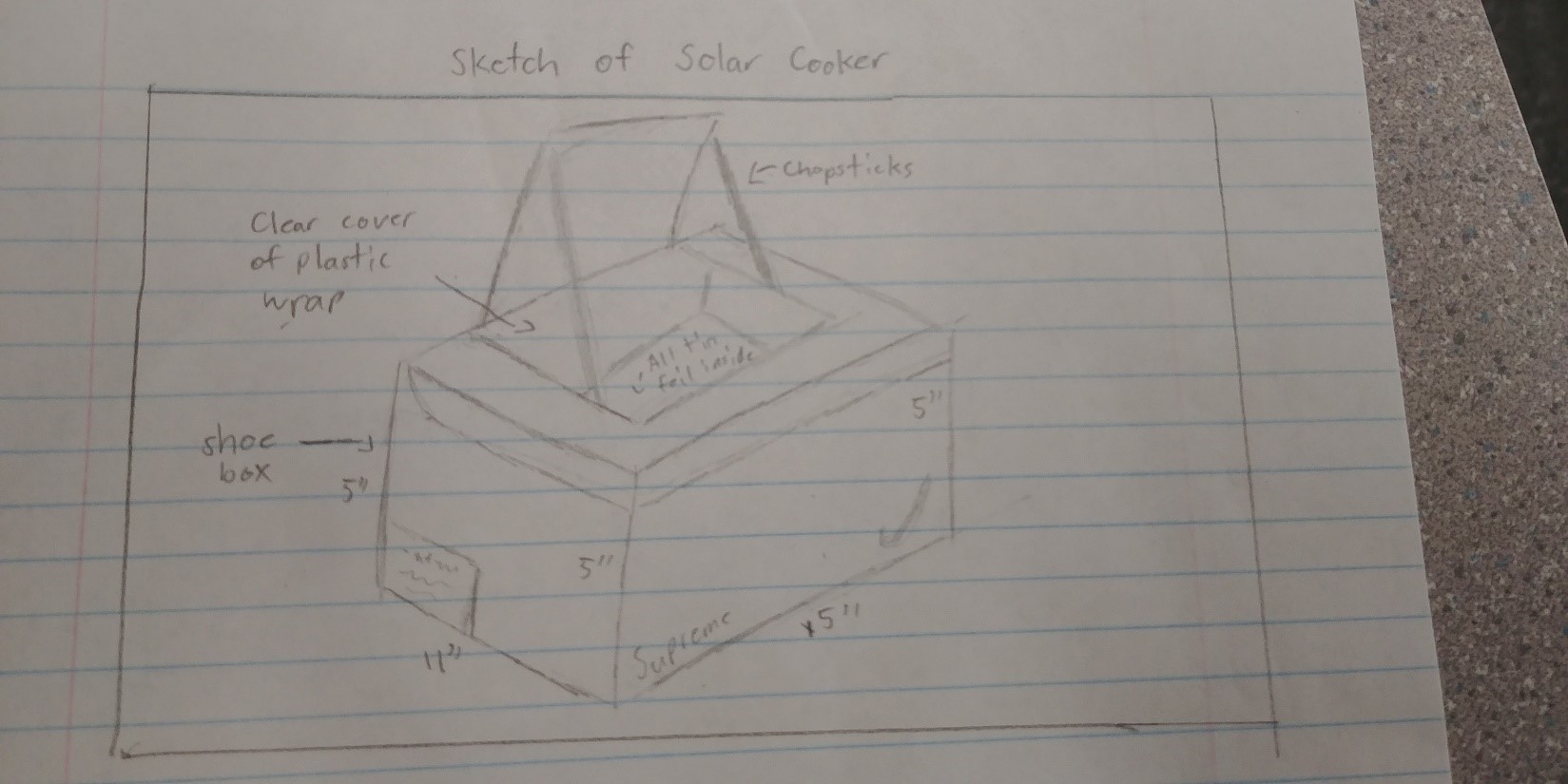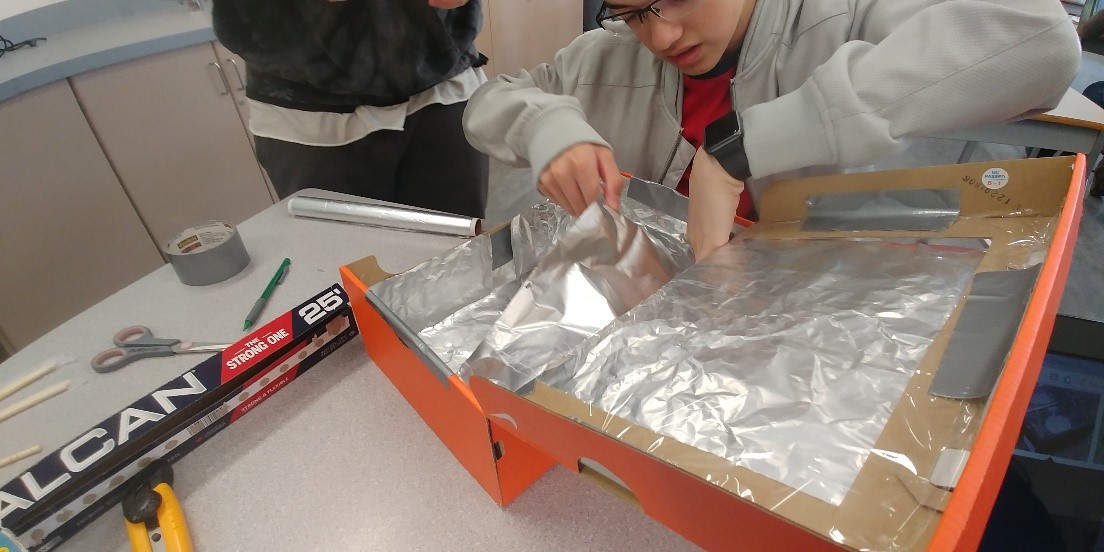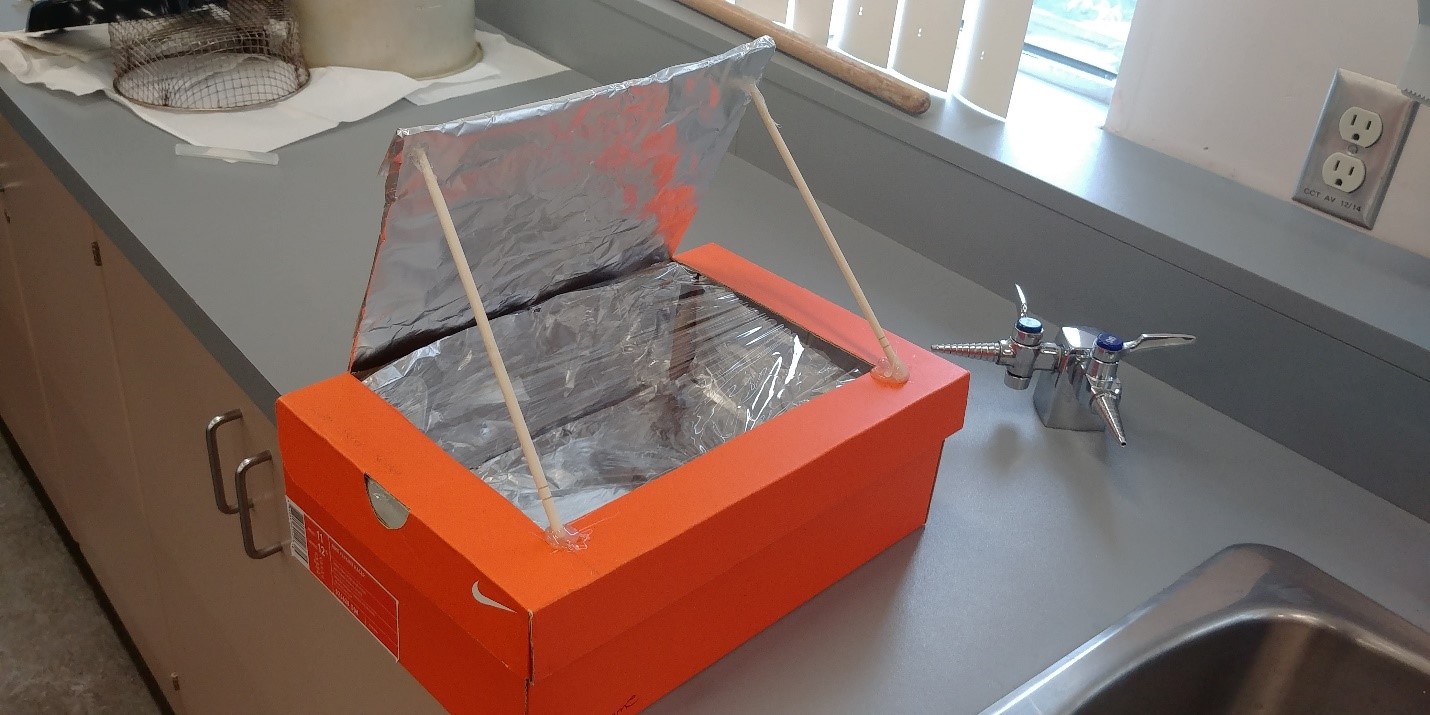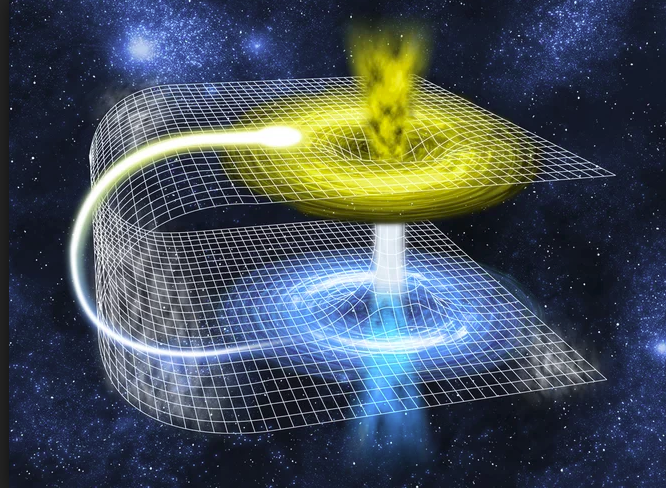Solar Cooker
Procedures:
- Get a shoe box
- Draw and cut a rectangular fold on the top (lid)
- Take measurements of the inside of the box
- Use the measurements to cut the tin foil pieces for each side
- Use a glue stick and glue the tin foil pieces to each side
- Duct tape the corners/inside to make sure it won’t accidentally fall off
- By using the chopsticks, glue it on vertically on each side of the flap so that the flap will be held open
- Under the main shoebox flap, set a sheet of clear plastic food wrap over the space and make sure it fits properly
- All done!
(When redesigning the shoe box for improving its effectiveness, use black construction paper on the sides so it will attract more heat and thus keep more heat inside the box)
Materials:
Duct Tape
Shoebox
Chopsticks
Smores
Metal plate
Plastic wrap
Scissors
Ruler
Advantages
-Easy to make
-Extremely safe
-Fewer chances of “tipping” over compared to other designs
-Usually more airtight, which allows for more heat to be insulated, and creates a higher and more efficient cooking “environment”
-All materials are cheap and cost-efficient
-Not affected by things like a gust of strong wind
-Can be left unattended for longer periods of time because of the design
Disadvantages
-Is not able to reach temperatures as high as other designs such as a parabolic cooker
-The process of heating can take longer than other designs
-Box size is limited, so you would not be able to heat up things like a pot of water
Solar Oven Shoebox
Solar ovens are similar to panel cookers, but they use an insulated box to retain heat, along with a set of reflective panels to concentrate solar energy. The sunlight hits the panels and bounces into the box, where the heat gets trapped. Solar ovens can reach temperatures comparable to those of traditional gas and electric ovens (in the region of 400°F). A solar oven is just as easy as your oven in your indoor kitchen. Consider using dark-colored bakeware, which absorbs and retains heat better than light-colored pans and casseroles. Although they retain more heat than panel cookers, solar ovens are also slow-cookers. They heat up gradually to baking and roasting temperatures.
Pros:
-traps the light and heat more in the box
-pretty simple to build
-can reach up to 400°F
-best for baking and roasting
Cons:
-they are slow cookers and heat up gradually
-less light gets in from the angle of the top flap
-must be sheltered a little from wind
Panel Cooker
Solar panel cookers are the simplest type of solar cooker. They typically generate the lowest temperatures. They use flat or slightly curved reflective surfaces to concentrate light onto cookware. You unfold the panels, align them to the sun, enclose the pot in a heat-resistant plastic bag, glass bowl, or polypropylene greenhouse, place the pot inside the cooker. Panel cookers are most effective when sheltered from the wind. Because they are not insulated, they are not recommended for use below 18 C or 65 F. Panel cookers are best for slow, small dishes. For the most efficient cooking, a panel cooker should be re-positioned once every hour to track the sun.
Pros:
-most simple to make out of all the solar cookers
-best for slow, small dishes
Cons:
-generate the lowest temperatures
-must be no wind because they are so open
-Because they are not insulated, they are not recommended for use below 18 C or 65 F
-a panel cooker needs to be re-positioned once every hour to track the sun
Parabolic Solar Stove
Parabolic solar stoves concentrate sunlight on the cookware, and the most efficient ones generate temperatures over 450°F. Parabolic solar stoves can cook from just after sunrise until just before sunset even in sub-zero temperatures, as long as they have direct access to the sun. They generate heat by using a curved reflector to concentrate light on the bottom of the cookware. The power of a solar stove’s output is determined by the quality, size, and curvature of the reflector. This makes it shiny, durable and lightweight. Because solar stoves heat up so fast and get so hot, they are ideally suited for grilling, boiling, steaming, and frying.
Pros:
– concentrate sunlight on the cookware
-can generate temperatures over 450°F
-can cook anywhere even in sub-zero temperatures as long as it is in the sun
– suited for grilling, boiling, steaming, and frying
Cons:
-hardest to make
-quality matters the most
-most expensive
Which one is best for us?
I think the best one for us is the solar oven. I think this because I feel like it is the most practical, also it is the cheapest to make and it isn’t the simplest to make but it isn’t the hardest to make so it will make us feel that we still worked hard on it and we didn’t just take the easiest one. Also, it traps the heat in unlike the other ones, so I feel like it would work the best with the little light we will have. Another reason we I think this one would work the best is it is very reliable and one that we feel would work the best under the circumstances.
Taste test
For our smores, we did 3 trials with one being 10 min another being 20 minute and the last being 30 minutes.
For the first trial (10 min) the marshmallow was a little warm and the chocolate was melted but very thick, the marshmallow was chewy, it was pretty much a warm raw marshmallow.
For the second trial (20 min) the marshmallow was warmer than in the first trial but still not toasted, and it was softer in the inside, the chocolate was completely melted and was dripping off the side at a very fast rate.
For the third trial (30 min) the marshmallow was in the middle between warm and hot, and had a very faint browning, and was very soft on the inside, the chocolate was again very melted and was dripping off the side of the gram cracker at a very fast rate.
The Science Behind Cooking
 Loading...
Loading...
Redesigning
For our solar cooker, we used the general shoebox design. The idea of reflecting the sun rays into the box using tin foil was implemented, but we thought that there was still room for improvement. After some research, we found an interesting science behind the interaction between different colours and heat and light. Although heat and light are both different types of energy, light can easily be converted to heat (and vise versa). Now, if we look at an object that is black, its property absorbs all the wavelengths from light. This converts into heat. A white object would do the complete opposite and reflect all the wavelengths, and there would be substantially less heat.
By knowing the science behind the interaction of these colours, it gave us a great idea that could’ve been implemented in our solar cooker to improve its effectiveness. Why not use black paper all around the inside structure? This would allow more heat to be trapped in the box, and thus, the raised overall inside temperature would allow the food inside to cook much more effectively. The tin foil reflecting light into the box and the black paper absorbing part of it would work hand-to-hand together. Overall, the changes may be small, but it created much more potential for our solar cooker. Many cool things can happen when you manipulate science to work for you 🙂
Citations:
“How Does Solar Cooking Work?” Solar Cooker – Solar Cooking, CantinaWest, www.solarcooker-at-cantinawest.com/solarcooking-howitworks.html.
“Solar Ovens: Food Fueled by the Sun.” How to Save Energy at School, Save on Energy,
Admin. “Compare Solar Cookers – Our How To Guide.” SolSource by One Earth Designs, One Earth Designs, 1 Nov. 2017, www.oneearthdesigns.com/blog/compare-solar-cookers/.
“The Advantages and Disadvantages of a Solar Cooker.” Solar Powered Cooker – Pros and Cons of Various Designs, Alterntiveenergygeek, www.alternative-energy-geek.com/solar-powered-cooker.shtml.
“Solar Cookers 101: How to Make One, The Different Types of Solar Cookers, and How They Work | Listly List.” Listly, Listy, list.ly/list/1Hi7-solar-cookers-101-how-to-make-one-the-different-types-of-solar-cookers-and-how-they-work.
“Why Do Black Objects Absorb More Heat (Light) than Lighter Colored Objects? What Do Wavelengths Have to Do with It?” UCSB Science Line, MRL, scienceline.ucsb.edu/getkey.php?key=3873.
RAW NOTES:
A solar cooker lets the UV light rays in and then convert them to longer infrared light rays that cannot escape. Infrared radiation has the right energy to make the water, fat and protein molecules in food vibrate vigorously and heat up.
It is not the sun’s heat that cooks the food, nor is it the outside ambient temperature, though this can somewhat affect the rate or time required to cook, but rather it is the suns rays that are converted to heat energy that cooks the food, and this heat energy is then retained by the pot and the food by the means of a covering or lid.
This occurs in much the same way that a greenhouse retains heat or a car with its windows rolled up. An effective solar cooker will use the energy of the sun to heat a cooking vessel and efficiently retain the energy (heat) for maximum cooking effectiveness.
For maximum efficiency, it is necessary to “track” the sun, or in other words adjust your solar cooker so that it is directed towards the sun in order to be able to better concentrate and absorb the suns rays.
This does not mean that you must continually stand beside the solar cooker the whole cooking period, but it can mean adjusting the angle and direction every so often or every set period, such as every one to two hours.
The more direct that the sun’s rays are towards the food and cooking pot the greater the energy (heat) capacity will be from the sun’s converted rays.
Ideal cooking results when using a solar oven occurs when the sun is bright and uninhibited or unimpeded by clouds, shadows etc.
Cooking can be accomplished as well on days when the clouds are high and thin, but it may slow things down a bit, and one would be wise to start a little earlier than usual.
Long, slow moderate solar cooking, such as with stew, chili, veggies etc. will do fine under less than bright skies if you allow more time.
Baking, on the other hand, will take longer and the temperatures will not be as optimum as could be, thus resulting in mixed outcomes with your baked goods.
Instead of converting solar energy into electricity, solar ovens trap light particles, called photons, to generate heat. With the help of metal reflectors, which are positioned around the oven to maximize light input, photons pass through the oven’s transparent glass top and strike the interior of the insulated box.
For best results, a dark, metal pot is placed at the center of the oven, where it can absorb the incoming photons. Once the cooking pot becomes warmer than the surrounding air, the heat attempts to escape to a cooler space. However, since it cannot break through the glass barrier, it remains trapped inside. As heat is reflected back to the metal pot, the oven’s temperature rises rapidly – up to a scorching 400 degrees Fahrenheit.
If you’ve ever left your car outside for a few hours on a sunny summer day, you’re already familiar with this phenomenon, formally known as the greenhouse effect. Sunlight enters your vehicle through the windows, heating up the seats and, before long, the entire interior.
Solar ovens operate in the same way, but these compact insulators allow you to cook in a proper pan instead of on your car’s dash.









